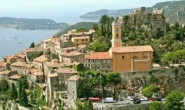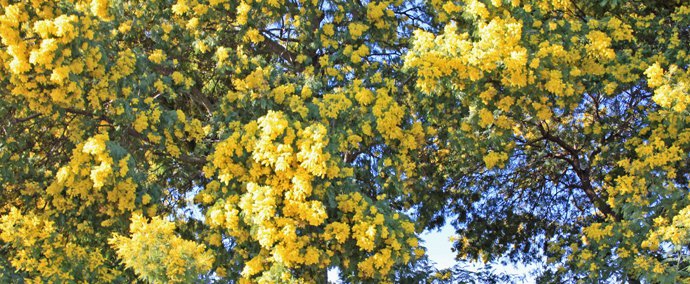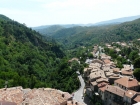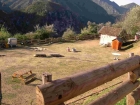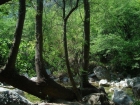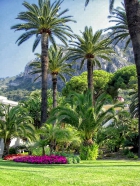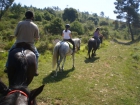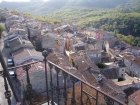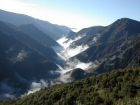Escapade The Mimosa Route
Distance: 130 km
Further information from the Tourism Offices of:
Bormes-les-Mimosas: +33 (0)4 94 01 38 38
Rayol-Canadel-sur-Mer: +33 (0)4 94 05 65 69
Sainte-Maxime: +33 (0)4 94 55 75 55
Saint-Raphaël: +33 (0)4 94 19 52 52
Mandelieu-la-Napoule: +33 (0)4 93 93 64 64
Tanneron: +33 (0)4 93 60 71 73
Pégomas: +33 (0)4 92 60 20 70
Grasse: +33 (0)4 93 36 66 66
All the beauty of the Côte d’Azur in winter
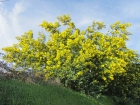 From January to March (and especially in February), the Mimosa Route invites you on a discovery of superb landscapes and beautiful villages, where brilliant yellow Mimosas stand out to stunning effect against the vibrant blue sky and sea. The Côte d’Azur is splendid in winter- in fact, it’s the best time to discover or even rediscover it!
From January to March (and especially in February), the Mimosa Route invites you on a discovery of superb landscapes and beautiful villages, where brilliant yellow Mimosas stand out to stunning effect against the vibrant blue sky and sea. The Côte d’Azur is splendid in winter- in fact, it’s the best time to discover or even rediscover it!
The Mimosa Route
The Mimosa Route itinerary takes you on an exploration of eight villages that give pride of place to the luxuriant flowers of the mimosa tree. The route starts in Bormes-les-Mimosas, in the Var and ends in the town of Grasse, in the Alpes-Maritimes.
Stage 1: Bormes-les-Mimosas
 This is one of the most beautiful villages to have been awarded the Village Fleuri label in France, and for good reason – it is home to over 700 rares plants. Bormes-les-Mimosas is also famous for the Fort de Brégançon, where, since 1968, France’s presidents come to holiday, 12km of superb beaches and a typical old village that includes narrow lanes, chapels and even a castle.
This is one of the most beautiful villages to have been awarded the Village Fleuri label in France, and for good reason – it is home to over 700 rares plants. Bormes-les-Mimosas is also famous for the Fort de Brégançon, where, since 1968, France’s presidents come to holiday, 12km of superb beaches and a typical old village that includes narrow lanes, chapels and even a castle.
Stage 2: Rayol-Canadel sur Mer
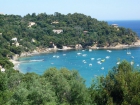 Rayol-Canadel sur Mer is a quiet village where nature reigns supreme, located 15km from Bormes-les-Mimosas. The Domaine du Rayol is an enormous 20 hectare garden that showcases Mediterranean plants at their very best, but also includes plants from around the world. Of course, you will learn how Mimosas, although good for gardens, are an invasive competitor to native plants.
Rayol-Canadel sur Mer is a quiet village where nature reigns supreme, located 15km from Bormes-les-Mimosas. The Domaine du Rayol is an enormous 20 hectare garden that showcases Mediterranean plants at their very best, but also includes plants from around the world. Of course, you will learn how Mimosas, although good for gardens, are an invasive competitor to native plants.
Stage 3: Sainte-Maxime
 Sainte-Maxime is a beautiful town whose tempting pedestrianised roads are ideal for strolls and shopping in its markets (Thursday and Friday morning). You will find Mimosa growing in the Myrtes botanical garden. Visits are tailored to persons with impaired vision.
Sainte-Maxime is a beautiful town whose tempting pedestrianised roads are ideal for strolls and shopping in its markets (Thursday and Friday morning). You will find Mimosa growing in the Myrtes botanical garden. Visits are tailored to persons with impaired vision.
Sainte-Maxime is also the venue for some great Mimosa festivals: a Miss Mimosa competition, decorated floats, a flower parade, concerts, shows and, of course, the distribution of mimosa!
Stage 4: Saint-Raphaël
 Saint-Raphaël is both a new and historic town offering all the pleasures of a small coastal town: beaches, coastal walks, and the mythical Island d’Or. In February, carnaval festivities celebrate the region’s flowers, including mimosas. On 11-12 February why not discover the landscape exhibition/competition in the Jardins Éphémères and on the last weekend in February enjoy the flower festival in Agay?
Saint-Raphaël is both a new and historic town offering all the pleasures of a small coastal town: beaches, coastal walks, and the mythical Island d’Or. In February, carnaval festivities celebrate the region’s flowers, including mimosas. On 11-12 February why not discover the landscape exhibition/competition in the Jardins Éphémères and on the last weekend in February enjoy the flower festival in Agay?
Stage 5: Mandelieu-la-Napoule
 Now we cross over into the Alpes-Maritimes, where we’ll stop in Mandelieu-la-Napoule. This is the starting point for the Route d’Or, which snakes through the middle of the largest Mimosa forest in Europe. It is here that the famous annual Mimosa Festival is hosted in mid-February. Festivities include a Mimosa Queen competition, a flower parade, flower competitions, and so on.
Now we cross over into the Alpes-Maritimes, where we’ll stop in Mandelieu-la-Napoule. This is the starting point for the Route d’Or, which snakes through the middle of the largest Mimosa forest in Europe. It is here that the famous annual Mimosa Festival is hosted in mid-February. Festivities include a Mimosa Queen competition, a flower parade, flower competitions, and so on.
Stage 6: Tanneron
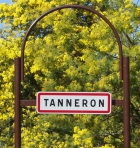 Tanneron is THE Mimosa town: 200 hectares of its territory are covered in Mimosa trees! Here you will discover plantations and hot-houses (available to visit by appointment only), mainly located in the Tanneron mountains. In the beginning of February, Tanneron hosts a Mimosa Festival, once the village square has been decorated with mimosas. Throughout the trees flowering season, you will be able to taste delicious Mimosa products available from the village market: sweets, honeys, etc.
Tanneron is THE Mimosa town: 200 hectares of its territory are covered in Mimosa trees! Here you will discover plantations and hot-houses (available to visit by appointment only), mainly located in the Tanneron mountains. In the beginning of February, Tanneron hosts a Mimosa Festival, once the village square has been decorated with mimosas. Throughout the trees flowering season, you will be able to taste delicious Mimosa products available from the village market: sweets, honeys, etc.
Warning: picking mimosa is strictly forbidden in the commune of Tanneron.
Stage 7: Pégomas
 In Pégomas, you will find a mimosa garden, home to many varieties of mimosa. Mimosa celebrations are held here towards the end of January.
In Pégomas, you will find a mimosa garden, home to many varieties of mimosa. Mimosa celebrations are held here towards the end of January.
Stage 8: Grasse
 The Mimosa Route ends in Grasse, the world capital of perfume, naturally. Here, mimosa flowers play a special role in perfume creation. While in Grasse, you must visit the international museum of perfumery and, most of all, its superb Mimosa gardens when they are in flower.
The Mimosa Route ends in Grasse, the world capital of perfume, naturally. Here, mimosa flowers play a special role in perfume creation. While in Grasse, you must visit the international museum of perfumery and, most of all, its superb Mimosa gardens when they are in flower.
the line is an indicative and approximate line

 Book holidays
Book holidays holiday Rental
holiday Rental Stays in residence
Stays in residence discounts
discounts Book hotel
Book hotel Stays
Stays Excursions
Excursions Sailing and Boating
Sailing and Boating Beaches and seaside
Beaches and seaside Hike
Hike Tourism
Tourism Discoveries
Discoveries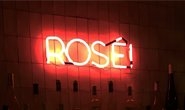
 Cinemas
Cinemas Films
Films Restaurants
Restaurants Recipes
Recipes Activities
Activities Outings
Outings
 car rental
car rental Corsica Ferries
Corsica Ferries Good ideas on the Riviera
Good ideas on the Riviera World within reach of Nice
World within reach of Nice Airline Tickets
Airline Tickets
 Real Estate
Real Estate Classified Ads
Classified Ads Facebook
Facebook
 Photo of the Week
Photo of the Week Agenda of the week
Agenda of the week Calendar
Calendar Horoscope
Horoscope Events
Events Our favorites
Our favorites